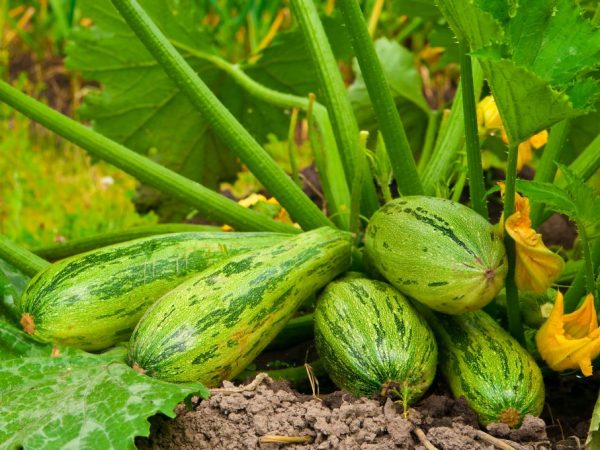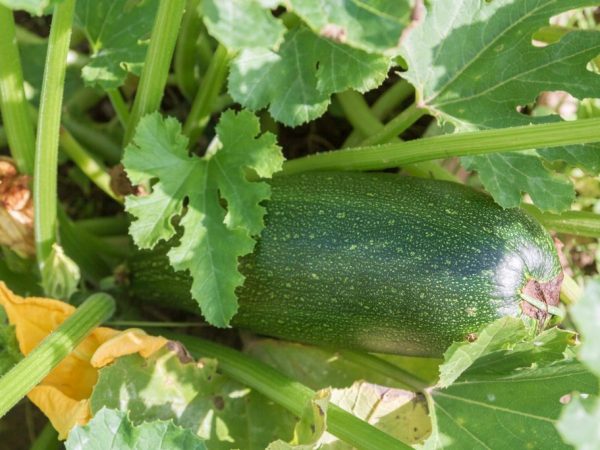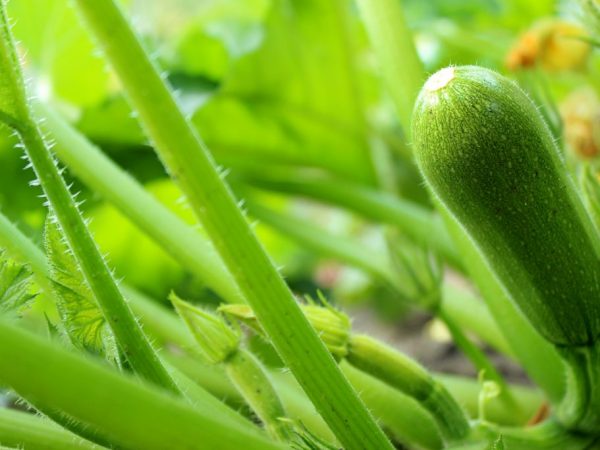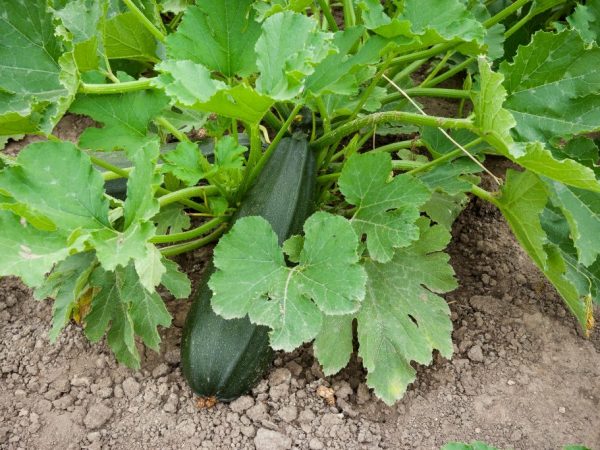Review of the best varieties of zucchini for open ground
Among the wide variety, one can single out the best varieties of zucchini for open ground, which grow well in any area and are not demanding to care for.
- Whether to buy zucchini hybrids
- Domestic or foreign variety
- The best varieties
- For the Leningrad region
- For Siberia
- Pharaoh
- For Moscow region
- For the Urals
- Early maturing varieties
- Mid-season varieties
- Skvorushka
- Kuand
- Late-ripening varieties
- High-yielding varieties
- Black handsome
- Mary Gold
- Cannon
- Self-pollinated varieties
- Dutch variety

Review of the best varieties of zucchini for open ground
Whether to buy zucchini hybrids
How hybrid crops differ from standard ones:
- different ripening periods and levels of fruiting;
- type of growth;
- pollinated by parthenocarpic or traditional hybrids, and standard species with the help of insects;
Hybrids are planted without shelter, they are often used for planting outdoors. Ordinary varieties are first planted in a greenhouse or after warming up the soil in the garden.
Additional advantages of hybrids - it is possible to control the growth of the bush, the neighborhood does not matter much, even the weeds do not interfere with their development. They are suitable for planting on any soil, give a stable harvest, while being unpretentious in watering, fertilizing and lighting the land.
Domestic or foreign variety
During the breeding work, many hybrids were bred with the characteristics necessary for the region: resistant to sudden temperature changes, with increased productivity, etc.
The best foreign cultures take root quite well in our country. For example, the popular variety of Zucchini.
Distinctive features of Russian and foreign zucchini:
- Domestic vegetables have tasty and sweetish pulp. Such fruits can be preserved and they do not lose their characteristics. The varieties are adapted to frequent temperature changes.
- The imported vegetable has a thinner skin. Inside is a small seed box. The pulp is firm and tasty. most often they are used to create a variety of dishes. Such fruits do not stagnate on bushes and are of the same size.
- Imported goods do not differ in storage duration. In this case, domestic cultures stand out favorably.
- Foreign hybrids are demanding on the level of humidity, and they are thermophilic, and domestic ones are winter-resistant.
The best varieties
For the Leningrad region

Some varieties are resistant to disease
Foreign hybrids are suitable for open ground in the Leningrad Region.
Iskander
The Dutch culture will quickly take root in difficult conditions, characterized by an over-yielding capacity.
The vegetable is protected from most diseases. The average ripening period is 40 days (depending on the ambient temperature).
Fruits are light green, oval in shape, thick skin. Approximate weight - 700 g and length - 20 cm.
Up to 17 kg can be removed from one bush during the year.
Tsukesha
Suitable view for the Leningrad region.
Tsukesha is a versatile medium-ripening crop. The hybrid popular among gardeners is distinguished by exposure to frost. Dark vegetables with black specks, weighing up to 1 kg, 30 cm long.
Begins to bear fruit on the 40-50th day, harvest until late autumn, it can be stored for up to 4 months.
The yield is stable. From a bush, you can get up to 12 kg of fruit.
For Siberia
In this area, it is better for a gardener to choose an early-ripe Apollo or Ardendo variety (the crop can be harvested 45-50 days after planting).
Self-pollinated species are also suitable - Zucchini. They bear fruit at any temperature, are resistant to drought, and from excess moisture the fruits do not lose their taste.
Also, marrows for Siberia must be cold-resistant and moisture-resistant. Therefore, it is worth mentioning the varieties Pharaoh and Polar Bear.
Pharaoh
The crop is high-yielding, capable of withstanding a sharp drop in temperature.
The fruit is dark green with a dense skin. The weight of one is 1 kg. The storage period of the crop is up to 2-3 months.
Polar bear
The variety is large-fruited, it feels good in any soil.
Fruit weight can reach 3-4 kg. The skin is strong, the flesh is dense, there are a lot of seeds, but they are small.
This variety is not afraid of frost, and therefore harvesting can be carried out in the last month of autumn.
For Moscow region

The Tsukesha variety will delight you with its yield
Ideal varieties for the Moscow region: Gold, Tivoli or Tsukesh. They are distinguished by high yields and are resistant to adverse environmental conditions.
Zucchini also takes root well. In a cold dark room, they are stored for 1-1.5 months.
For the Urals
- For the Urals, varieties with an early ripening period are suitable - Iskander or Apollo - they are suitable for the climatic characteristics of the region, ripen in 1.5-2 months (before the onset of cold weather).
- Skvorushka and Black Beauty are late varieties, but they are disease resistant and provide a stable yield.
- Anchor and Astoria endure sudden temperature changes and do not get sick with fungal diseases. In addition, prevention is carried out, which increases the chances of getting a full harvest at the beginning of autumn.
- Zucchini is suitable for any climatic conditions. In the Urals, it is planted closer to summer, when the soil warms up well.
- Kaund and Yellow-fruited germinate quickly and require minimal care: applying moisture several times a season and 2-3 additional fertilizing during the period of active growth.
Early maturing varieties
Early zucchini are popular in regions with a pronounced transition between seasons. With the arrival of autumn, when it gets colder, the fruits cannot stay in the garden for a long period.
The average ripening period is 35-40 days.
- Kavili F1 is a high-yielding hybrid: up to 9 kg are removed from one bush. The entire fruiting period takes up to 2 months. The bushes are compact, the fruits are small (average weight - 300 g, length - 22 cm). The pulp is juicy and delicate in taste.
- Karisma. The main advantages are resistance to common diseases, a quick ripening period and an annual rich harvest. You can pick the first vegetables on the 40th day after planting, they are stored for 2-3 months and are well transported.
- Roller. An early maturing species with a high yield rate. Vegetables ripen on the 35th day after planting. The weight of one fruit does not exceed 1.5 kg. It is grown outdoors without shelter. All he needs is watering and loosening the soil.
Mid-season varieties
Skvorushka
Refers to the type of Zucchini. Ripens 45 days after planting.
The fruits are large and heavy (up to 1 kg). They have good keeping quality and can be easily transported.
Kuand
Mid-season and popular species. Differs in high productivity and resistance to disease, withstands sudden cold snaps and does not suffer from excess moisture.
The fruits are ovoid, elongated. The weight of one is 1 kg. The average ripening period is 60 days.
Late-ripening varieties

Late varieties yield a harvest four months after planting
The most popular late variety of zucchini is Spaghetti. The harvest is formed within 120 days. Small hybrid bush. Fruits are elongated with orange skin. The length of one vegetable is 30 cm.
Benefits:
- the skin is of high density;
- inside the pulp is bright orange;
- after heat treatment, the pulp is divided into "threads" - thanks to this feature, the species got its name;
- the weight of one vegetable is 1.5 kg;
- the shelf life of a ripe vegetable is 4 months;
- varieties similar in properties - Tivoli and Raviolo.
High-yielding varieties
For open ground in a territory with a temperate climate, high-yielding varieties are selected - more often they are planted for sale or for long-term storage in the winter.
Black handsome
Ripens on day 55, resistant to disease and sudden changes in temperature. The bush is compact. The yield of the hybrid is 20 kg.
Mary Gold
The zucchini has a bright golden color. Its length does not exceed 22 cm. Mary Gold is picky about feeding and moisturizing, but if all the rules of care are followed, it gives a stable harvest.
Cannon
According to the description, zucchini belongs to early maturing crops, so a full harvest is collected on day 35.
The variety is unpretentious in care and resistant to common diseases. Differs in extended fruiting and good transportability.
The fruits are stored in a cool room for 2-3 months.
Self-pollinated varieties
Among the self-pollinated varieties, Apollo stands out. This is an early maturing species that grows well in the shade and withstands the first frost. Ripening period - 40 days.
Self-pollinated hybrids for small plots:
- Aeronaut. The plant is not only compact, but also highly resistant to common diseases. Fruit color is green. The length of one vegetable is from 14 to 16 cm. The average yield per bush is 8 kg.
- White. Differs in a fast ripening period. The fruits have a characteristic white skin. The first harvest takes place on the 40th day after planting. The shape of the fruit is oval, slightly elongated.
Dutch variety
If you choose the most unusual hybrid of Dutch breeding, then there is no better option than the Amyad variety.
The fruiting period is up to 40 days. The shape of the fruit is elongated. Average weight - 200-250 g, length - 18 cm.
Suitable for growing outdoors or in greenhouse conditions. The inside of the vegetables is soft but firm. The yield is stable, the variety itself is resistant to common diseases.

